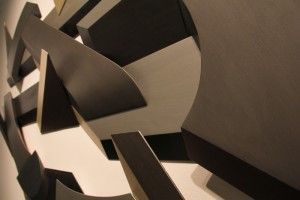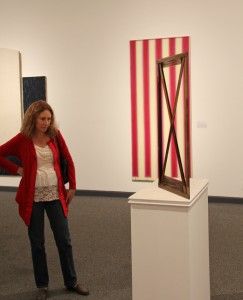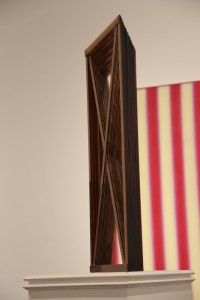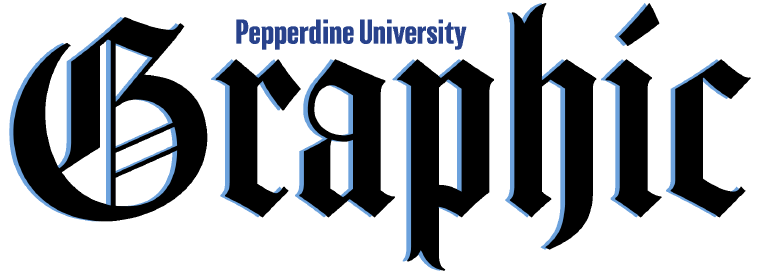
This year’s art exhibit put on by the Weisman Museum found a compelling niche local residents would be interested in viewing: their own culture. The Weisman’s California Art exhibit showcases Southern California artists and their artwork from the ’60s, ’70s and ’80s as an eclectic collection personifying the sunshine culture, as well as our inclination for counterintuitive thought.
To the unseasoned eye, the ground floor collection seems more modern than Southern Californian. One of the first pieces to catch the eye is a hallucinogenic wall sculpture by Robert Irwin, called “Untitled.”
Taking a few steps back, the viewer witnesses the complicated optical effect created by a strikingly simple plastic curvature protruding from the wall. The color of the half-orb brings to mind overcast clouds, which blur the line between the object and its shadows cast on the wall. Irwin cleverly plays with lighting effects so that light itself becomes more a part of the work than the sculpture, all the while offering the viewer a playfully perplexing piece at which to gaze. The concepts lurking between the art, space and light of the work unperceptively alter the viewer’s expectations of the exhibit from enjoyment to a more contemplative state of mind. However, the stimulating effect of Irwin’s “Untitled” quickly falls flat against the minimalist paintings with which it cohabitates.

Instead, the bright primary colors and bold pastels draw the viewer into the greater, main room of the museum. Here, the “California” in “California Art” finds its way to the front of the mind, finally finding the visual stimulation worthy of being called Californian.
The room as a whole emits the spunk and individuality Southern Californians are so known for, but after closer analysis, it leaves viewers wanting. The big baby-room-pastel-pink plank leaning against the wall horribly sticks out as more as a piece of construction than actual art. The oddly out-of-place piece, named “The Case for Fakery in Beauty” by John McCracken, seems to fall too short in the scheme of California art, which, yes, triumphed a more laid-back art, but this seems just lazy.
Taking a few steps past the plank, a more notable piece would be “Yellow and Blue” by Craig Kauffman. This 1965 piece fell straight out of a comic book to challenge the artistic norms New York artists so stringently perpetuated; its bright yellow acrylic backdrop would be so characteristic of Southern California’s sunshine if it wasn’t for the simplified, curvy cartoon raincloud popping out of the surface. In a way, it satirizes rainstorms in Southern California, playing up our bright culture and perhaps even our exaggerated reactions to rainy days, which Seattle residents could easily justify as mist. As ironic as the raincloud may be in this California Art exhibit, its playful mood and satiric tone is what makes this piece the most “Californian” in the bunch.
If Kauffman’s “Yellow and Blue” is at the apogee of Californianism, Charles Arnoldi’s chain-sawed “Impound” is its sordid counterpart. That is not to say that Arnoldi’s double wood construction of bursting colors next to a dark forest of sticks is not, in itself, a brilliant work of strenuous art. But its harsh contrast of color and content (a depiction of Mount St. Helen’s eruption and its aftermath), noticeably adds heaviness that most of the other works so valiantly attempt to counter.

The color and activity so present in the downstairs is stripped away in the monochromatic upstairs room. This, for some, may come as too stark a contrast from the downstairs until (despite the staircase one walks up) the viewer is drawn to John Baldessari’s “Horizontal Men.”
The coolness of the room provides an experience much different from the downstairs, but is still very much Californian, if not more so.
“Horizontal Men,” which is a compilation of nine different still images from movies depicting dead men, raises a new set of questions and observations in a brand-new context. In the tradition of deviating from the intellectual norm, Baldessari blatantly asks the viewer “where are we going?” He quickly answers it with the vertical-turned-horizontal man on bottom, who has presumably just been shot in the back, as our theatrically attuned minds would lead us to believe.
Tucked away in the corner is Jeff Colson’s “Figure,” which would have been an excellent piece to put in proximity to Baldessari’s work because it asks the same question about our communication. The wall sculpture from far away resembles the shape of a scroll, curled slightly at the ends, but close up it is made up of an amalgamation of layered paper-like, parchment-colored rectangles. The ambiguity of the paper — whether printer paper, legal-sized paper or perhaps even Post-Its — leaves the viewer wondering about the layers and differences of the means of communication, how they have changed and how they have not. The sculpture cleverly shows how paper, one of our main means of communication, has not really evolved, which may also be the case for our communication.
Tim Hawkinson’s “The Fin Within” presents yet another challenge of mainstream thought. Walking away from the remote corner of Colson’s “Figure,” Hawkinson’s sculpture doesn’t call much attention to itself; it’s only upon further inspection that the viewer finds the real sculpture hidden “outside the lines” of what looks like a mermaid fin. The sculpture is rather an impression — the negative space between a pair of legs, and the impressions of which create the shape and substance for the fin. Hawkinson cunningly calls the viewer to look from a different perspective, and how so much more could be found by “reading between the lines.”
Though the Weisman’s California Art exhibit does showcase some big names like Ed Ruscha and John McCracken, the more unknown works are what leave a greater impression — inverted or not — on the viewer.

